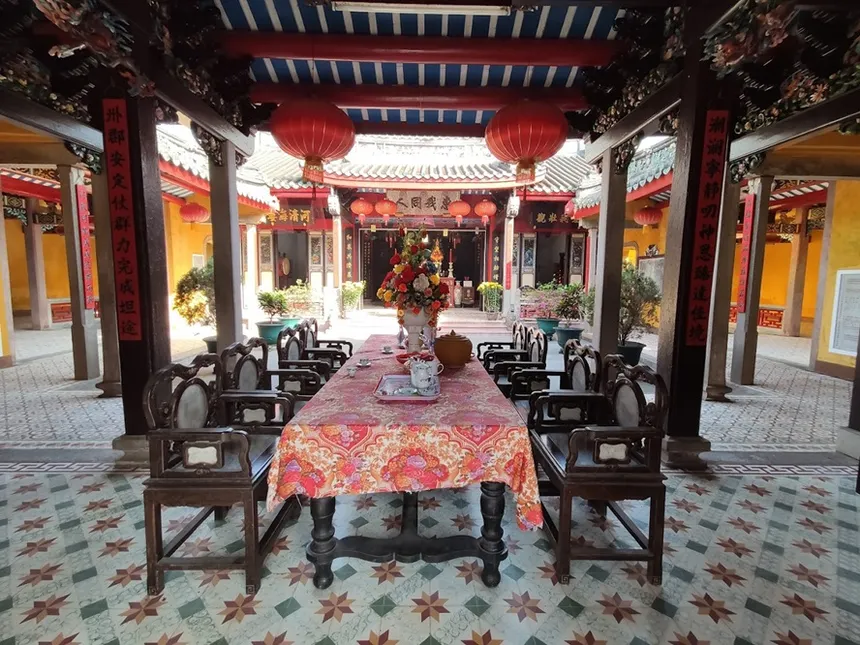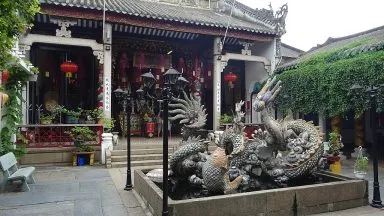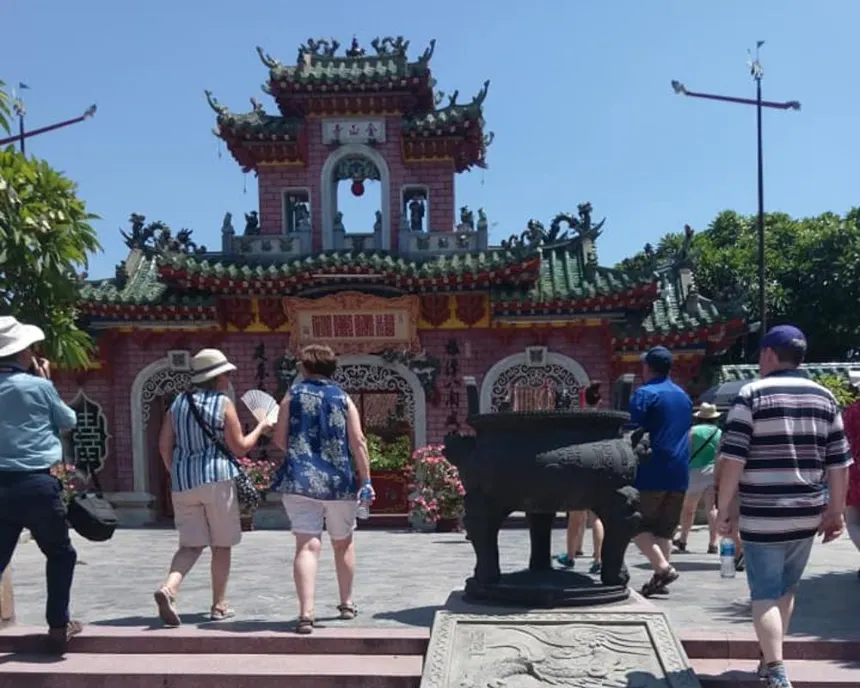Visiting the Cantonese Assembly Hall in Hoi An: Opening Hours, Entrance Fee, and Location by Ovuigo
If you seek a place that embodies the layered history and multicultural spirit of Hoi An Ancient Town, the Cantonese Assembly Hall is a must-visit. Located centrally at 64 Tran Phu Street, Minh An Ward, Hoi An, Quang Nam, this famed assembly hall stands near the Japanese Covered Bridge—lighting the way for heritage explorers and first-time visitors alike. The hall lies within the UNESCO World Heritage zone, making it an essential stop for anyone interested in Chinese heritage sites or Vietnamese architecture.

Opening Hours and Entrance Fee
The Cantonese Assembly Hall opens daily from 7:00 AM to 11:00 AM and from 2:00 PM to 4:00 PM. To explore this cultural marvel, the entrance fee is 120,000 VND (about $5 USD). This ticket often grants access to several other historic buildings and assembly halls within Hoi An Ancient Town, so keep your ticket handy as you stroll the charming streets.
How to Get There
To reach the assembly hall, make your way to Tran Phu Street. If you’re starting from Hoi An Old Town’s main entrance or the iconic Japanese Covered Bridge, you’ll find the Cantonese Assembly Hall less than a five-minute walk away. Exact map location: View on Google Maps.
Should you need personalized advice or want to book a walking tour, feel free to contact ovuigo.com via WhatsApp at +84 868 319 161.

Historical Background of the Cantonese Assembly Hall and Its Chinese Community Roots
Delving into the Cantonese Assembly Hall history in Hoi An reveals a tale of migration, adaptation, and community pride. Built in 1885 by Cantonese Chinese immigrants, the hall’s primary function was to serve as a hub for communal gatherings, worship, and social support among the growing Chinese diaspora in Central Vietnam. The Chinese community, particularly the Cantonese, played a pivotal role in Hoi An’s emergence as a commercial crossroads. Their influence stretched beyond trade; they helped shape cultural and religious life in the region, leaving a legacy embedded in local customs, festivities, and architecture.
The assembly hall itself was a beacon of unity. It brought together merchants, artisans, and families, providing both spiritual and practical resources to its members. Over time, the Cantonese Assembly Hall became a symbol of the enduring relationship between Hoi An’s Chinese residents (often referred to as Nam Hoi China) and the broader Vietnamese community. This close-knit bond is reflected in the site’s architectural flourishes, ceremonial artifacts, and ongoing use as a place for ancestral worship and holiday celebrations.
Today, the hall remains one of Hoi An’s most important Chinese heritage sites, attracting not just tourists but descendants of those early immigrants who helped forge Hoi An’s unique identity. It stands alongside other assembly halls—such as the Fujian and Trieu Chau—testifying to the lasting cultural exchange that defines the UNESCO World Heritage Site.

Architectural Marvels: Chinese-Vietnamese Design and Iconic Features of the Cantonese Assembly Hall
The architecture of the Cantonese Assembly Hall is an exemplar of a successful fusion between traditional Chinese and local Vietnamese design. Built primarily from stone and wood, the structure features ornate curved eaves, bold red and gold color schemes, and impressive stone dragon sculptures—symbols of fortune and strength in both cultures. The most striking symbol is the dragon fountain centerpiece, located in the main courtyard, making for a focal point of spiritual energy and photographic interest.
The gates are guarded by imposing guardian lion statues, while the halls house ancestral altars, elaborate calligraphy plaques, and incense burners where daily worship rituals are performed. You’ll find red lanterns suspended from the ceilings, each representing prosperity and celebration, especially during festivals or lunar occasions. Notable are the intricate woodwork and painted panels depicting scenes from Chinese folklore.
Despite these Chinese signatures, Vietnamese architectural influences abound as well, such as tiled roofs and earth-tone detailing, reflecting the hall’s location amidst a Vietnamese cultural landscape. This blend serves as both an artistic and historical testament to communal harmony, as locally sourced materials and traditional techniques were integrated into a distinctly Cantonese vision.
If you have an eye for detail, pay special attention to rare attributes—such as original altar artifacts and rare Chinese inscriptions—and imagine the secret meeting rooms where community elders once plotted strategies or debated social welfare issues.

Cultural and Religious Importance: Festivals, Altars, and Community Use
More than just a historic building, the Cantonese Assembly Hall is a living monument to the customs and rituals that continue to unite Hoi An’s Chinese community. It assumes the dual role of temple and meeting house. The main altars are dedicated to Quan Cong (a revered Chinese general and deity), ancestors, and saints, with daily incense offerings signifying respect and continuity of tradition. Rituals for prosperity and health are conducted frequently—not only by locals but also by curious travelers drawn to the spiritual ambiance.
One of the most anticipated events here is the monthly Lantern Festival, when red lanterns fill the assembly hall, creating a magical glow. There are also major Chinese festivals, such as the Lunar New Year, when the building becomes even more of a social nucleus. Calligraphy plaques, drum performances, and traditional Chinese music enrich these celebrations, attracting participants from all backgrounds.
During quieter times, the hall functions as a gathering place for communal discussions, cultural workshops, and educational events. By serving both sacred and civic functions, the Cantonese Assembly Hall continues to foster a sense of belonging among Hoi An’s residents—including new generations of the Chinese diaspora.
To experience a festival or witness a ceremony, check the event schedule in advance or inquire with local guides (ovuigo can help you arrange a guided visit and share up-to-date event details).

Close Entities and Nearby Landmarks: Linking the Cantonese Assembly Hall to Hoi An’s Heritage Sites
The story of the Cantonese Assembly Hall intertwines with the tapestry of Hoi An’s most cherished historic sites. Merely a stone’s throw away lies the iconic Japanese Covered Bridge (Chua Cau)—another pillar of Hoi An’s multicultural legacy. The Fujian Assembly Hall and Trieu Chau Assembly Hall are also within walking distance, each representing different Chinese linguistic and cultural groups while sharing architectural kinship and ceremonial purposes with the Cantonese hall.
Other close entities, such as Tan Ky House and the Assembly Hall of the Hainan Chinese Congregation, offer glimpses into life in Hoi An during its golden age as a trading port. These landmarks often collaborate during major festivals or town-wide cultural promotions, and your entrance ticket to the Cantonese Assembly Hall may allow joint entry to these partner sites.
If your aim is to understand the depth of Chinese influence in central Vietnam, create a walking tour that includes these close entities—take in the architectural transitions, compare altars, and chat with knowledgeable caretakers for tales not found in guidebooks. Each site adds texture to the narrative of Hoi An as a crossroads of commerce, culture, and coexistence.
Preservation and Heritage Status: Protecting the Cantonese Assembly Hall for Future Generations
As a UNESCO World Heritage Site, the Cantonese Assembly Hall benefits from multiple layers of protection and restoration initiatives. Local authorities work closely with heritage experts and historians to safeguard original altar artifacts, stone dragon sculptures, and rare Chinese inscriptions. Regular maintenance, documentation, and educational outreach ensure that the hall remains accessible, informative, and engaging for visitors from around the world.
One major challenge is balancing the influx of tourists with the need for preservation—a task requiring both technical expertise and community involvement. Restoration projects often incorporate traditional materials and craftsmanship, with workshops sometimes held on site to educate both locals and travelers about preservation techniques.
Ongoing significance as a living site for worship, communal gatherings, and cultural events cements the assembly hall’s symbolic role in modern Hoi An. It is not merely a relic but part of the town’s living, evolving identity—demonstrating the resilience and adaptability of its founders and caretakers.
If you wish to support preservation efforts or learn about volunteer programs, connect with local organizations or ask your tour provider.
For comfortable and memorable stays in Hoi An, consider booking The Manor Hoi An, Hola 1, or Hola 2, all accessible via Airbnb and ideal for travelers looking for authentic local experiences.




